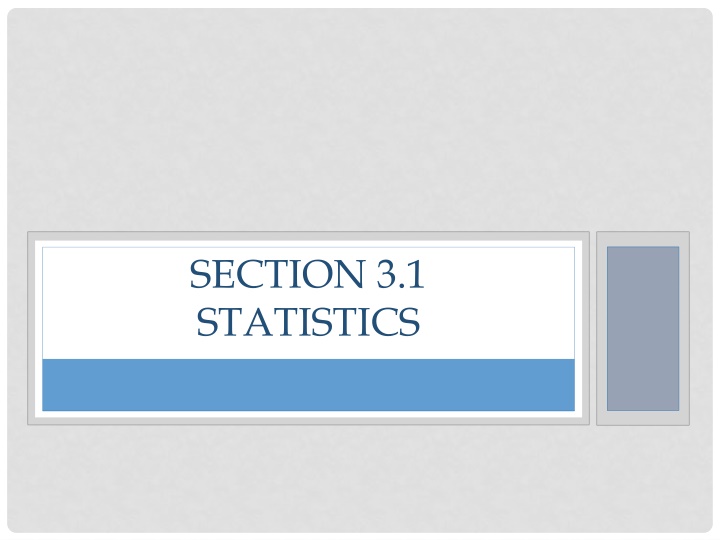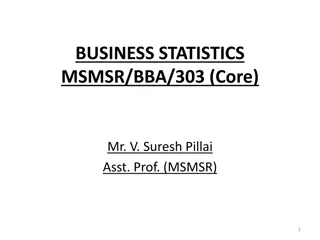
Understanding Statistics Fundamentals and Data Types
"Explore the basics of statistics, including concepts like population vs. sample, parameters vs. statistics, sampling methods, and categorical vs. numerical data. Learn to differentiate between types of data in various examples. Enhance your statistical knowledge with this insightful content."
Download Presentation

Please find below an Image/Link to download the presentation.
The content on the website is provided AS IS for your information and personal use only. It may not be sold, licensed, or shared on other websites without obtaining consent from the author. If you encounter any issues during the download, it is possible that the publisher has removed the file from their server.
You are allowed to download the files provided on this website for personal or commercial use, subject to the condition that they are used lawfully. All files are the property of their respective owners.
The content on the website is provided AS IS for your information and personal use only. It may not be sold, licensed, or shared on other websites without obtaining consent from the author.
E N D
Presentation Transcript
SECTION 3.1 STATISTICS
INTRODUCTION TO STATISTICS Statistics is the science of making effective use of numerical data relating to groups of individuals or experiments.
POPULATION AND SAMPLE A population is a collection or set of individuals, objects, or events whose properties, called variables, are to be analyzed. A sample is a subset of that population.
PARAMETER AND STATISTIC A value that represents the entire population is called a parameter. A value that is a measure of the sample is called a statistic.
EXAMPLE 1 Determine if the numerical value is a parameter or statistic. A) The population of Virginia is 7,650,000 B) In a sample of US House Holds, 62 % had internet service.
SOLUTION TO EXAMPLE 1 Solution: A) The population of Virginia is 7,650,000: Parameter B) In a sample of US House Holds, 62 % had internet service: Statistic
SAMPLING To obtain a simple random sample the goal is to get a sample that accurately represents the population that is being studied.
CATEGORICAL AND NUMERICAL DATA Types of variables 1) Numerical (Quantitative) Variables: Data in the form of numbers. 2) Categorical (Qualitative) Variables: Data in the form of non-numerical information.
EXAMPLE 2 Describe each example as either categorical data or numerical data. A) Number of residents in Fairfax County B) A phone number C) The name of a political party D) The number of votes needed to win the election.
SOLUTION TO EXAMPLE 2 A) Number of residents in Fairfax County: Numeric Variable B) A phone number: Categorical Variable (The data is a number, but the number does represent any quantity. The value is just randomly assigned) C) The name of a political party: Categorical Variable D) The number of votes needed to win the election: Numeric Variable
EXAMPLE 3 27 SUV s were randomly selected from a Ford Plant in Detroit. 2.1% were found to have defective airbags. A) What is the population? B) What is the sample? C) What is the statistic?
SOLUTION TO EXAMPLE 3 27 SUV s were randomly selected from a Ford Plant in Detroit. 2.1% were found to have defective airbags. A) What is the population? All the SUVs made by the Ford plant in Detroit B) What is the sample? 27 SUVs C) What is the statistic? 2.1% were found to have defective airbags.
EXAMPLE 4 A study of Math114 students were taken at the end of Spring 2018. A sample of 30 found 78% had a positive experience in the course. A) What is the population? B) What is the sample? C) What is the statistic?
SOLUTION TO EXAMPLE 4 A study of Math114 students were taken at the end of Spring 2018. A sample of 30 found 78% had a positive experience in the course. A) What is the population? All students who took Math114 in Spring 2018 A) What is the sample? 30 students A) What is the statistic? 78% had a positive experience in the course.
EXAMPLE 5 Which of the following is a parameter and which is a statistic? A) 99% RU students have a cell phone B) The yearly payroll of the payers on the Washington Capitals is $32,000,000. C) 82% of adults surveyed admit to drug use.
SOLUTION TO EXAMPLE 5 Which of the following is a parameter and which is a statistic? A) 99% RU students have a cell phone parameter A) The yearly payroll of the payers on the Washington Capitals is $32,000,000. parameter A) 82% of adults surveyed admit to drug use. statistic
EXAMPLE 6 Identify each as categorical data or numerical data A) The time of the woman s 200m run from the London Olympic B) The eye color of students in this class C) The social security number of the students in this class D) The zip code of all the post offices in New River Valley area.
SOLUTION TO EXAMPLE 6 Identify each as categorical data or numerical data A) The time of the woman s 200m run from the London Olympic numerical A) The eye color of students in this class categorical A) The social security number of the students in this class. categorical B) The zip code of all the post offices in New River Valley area. categorical






















